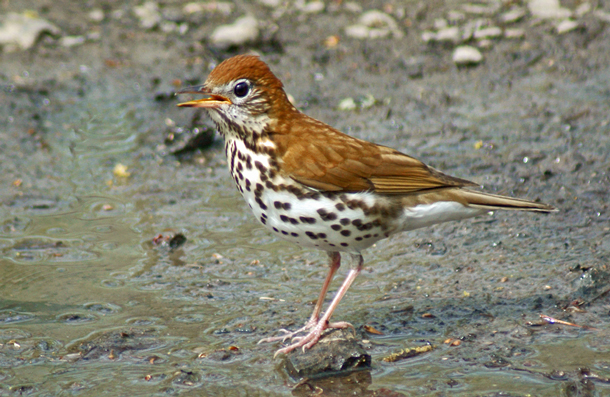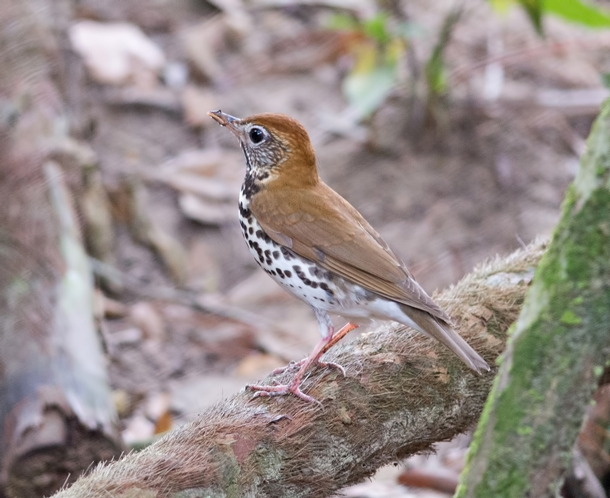BirdNote®: Henry David Thoreau and the Wood Thrush
Air Date: Week of June 7, 2019

The Wood Thrush is a small, pot-bellied bird, recognizable by its reddish-brown top feathers and speckled underparts. (Photo: © Greg Miller)
In June 1853, Henry David Thoreau wrote of an enchanting encounter with the Wood Thrush: "This is the only bird whose note affects me like music. It lifts and exhilarates me. It is inspiring. It changes all hours to an eternal morning." BirdNote®’s Michael Stein has more on these awe-inspiring birds.
Transcript
CURWOOD: The two-million-word journal of Henry David Thoreau is full of detailed
descriptions of the nature in and around Concord, Massachusetts. And like many of us who get out into the pine woods at dawn or dusk, the naturalist was especially taken with the song bird called the wood thrush. Here’s BirdNote®’s Michael Stein.
BirdNote®
Henry David Thoreau and the Wood Thrush
[Wood Thrush song]
STEIN: Perhaps as much as any man, Henry David Thoreau enjoyed his walks in the woods. In June 1853, Thoreau wrote in his journal of an enchanting encounter with the Wood Thrush:
“The wood thrush launches forth his evening strains from the midst of the pines. [Wood Thrush song throughout quotation] I admire the moderation of this master. There is nothing tumultuous in his song. He launches forth one strain with all his heart and life and soul, of pure and unmatchable melody, and then he pauses and gives the hearer and himself time to digest this, and then another and another … ” *
About a week later, Thoreau wrote again of the Wood Thrush: “This is the only bird whose note affects me like music … It lifts and exhilarates me. It is inspiring . . . It changes all hours to an eternal morning.” **

Wood thrushes thrive in expansive forests, and though they face threats from habitat loss, protected areas offer a home for these inspiring birds. (Photo: © Patty McGann)
[Wood Thrush song]
Wood Thrushes thrive in large expanses of forest. And their numbers have declined as forests have been cut on their breeding grounds and where they winter, in southern Mexico and Central America. Yet nearly half of Wood Thrush pairs have two broods per nesting season, so given a chance, their numbers could rebound. Protected areas like Adirondack Park, Great Smoky Mountains National Park, and Ozark National Forest give them that chance.
###
Written by Bob Sundstrom
Song of the Wood Thrush provided by The Macaulay Library at the Cornell Lab of Ornithology, Ithaca, New York. Recorded by G.F. Budney.
Producer: John Kessler
Executive Producer: Chris Peterson
© 2014 Tune In to Nature.org June 2018/2019 Narrator: Michael Stein
ID# SotB-WOTH-02-2011-06-05
Quotations from: Henry David Thoreau “Thoreau and the Birds”. In Hay, John (editor). The Great House of Birds. San Francisco: Sierra Club Books, 1996. p. 69-70. *June 14, 1853 **June 22, 1853
https://www.birdnote.org/show/henry-david-thoreau-and-wood-thrush
CURWOOD: For pictures, flit on over to our website, loe.org.
Links
Learn more at the BirdNote® Website
The Cornell Lab of Ornithology | “All About Birds: Wood Thrush”
Living on Earth wants to hear from you!
Living on Earth
62 Calef Highway, Suite 212
Lee, NH 03861
Telephone: 617-287-4121
E-mail: comments@loe.org
Newsletter [Click here]
Donate to Living on Earth!
Living on Earth is an independent media program and relies entirely on contributions from listeners and institutions supporting public service. Please donate now to preserve an independent environmental voice.
NewsletterLiving on Earth offers a weekly delivery of the show's rundown to your mailbox. Sign up for our newsletter today!
 Sailors For The Sea: Be the change you want to sea.
Sailors For The Sea: Be the change you want to sea.
 The Grantham Foundation for the Protection of the Environment: Committed to protecting and improving the health of the global environment.
The Grantham Foundation for the Protection of the Environment: Committed to protecting and improving the health of the global environment.
 Contribute to Living on Earth and receive, as our gift to you, an archival print of one of Mark Seth Lender's extraordinary wildlife photographs. Follow the link to see Mark's current collection of photographs.
Contribute to Living on Earth and receive, as our gift to you, an archival print of one of Mark Seth Lender's extraordinary wildlife photographs. Follow the link to see Mark's current collection of photographs.
 Buy a signed copy of Mark Seth Lender's book Smeagull the Seagull & support Living on Earth
Buy a signed copy of Mark Seth Lender's book Smeagull the Seagull & support Living on Earth

